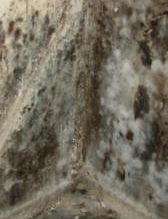 |
| The VOCs released by mold can make people sick, researcher says. |
Then Hurricane Katrina struck, Bennett’s home was flooded, and she evacuated.
A month later, she returned to the house to sample her home for mold. Her house smelled horrendous and even with protective gear, she felt awful – dizziness, headache, malaise. She walked outside and felt better.
Then it struck her: “I think there’s something in this terrible mold I’m smelling.”
But she still believed in her old arguments against the theory. She knew how much mold toxin we ordinarily get exposed to from mold in food, and she still knew that it was far greater than any we could breathe from spores in the air.
But the smell of mold was another matter. Most things we can smell are volatile organic compounds (VOCs), and some VOCs are known to make people sick.
“I knew that a minor theory was that sick building syndrome might be caused by the VOCs that make fungi smell moldy,” Bennett says.
And then she thought, “Maybe there is such a thing as sick building syndrome, and maybe it has nothing to do with the fungus toxins I’ve been studying all my life!”
That moment transformed her research career.
The Sniff Test
She focused on a VOC called “mushroom alcohol” that is the primary component of the typical smell of mold. It’s formed especially when molds eat linoleic acid, which occurs both in many biological cells and in building products like oil-based paint.
When fruit flies breathed in the mushroom alcohol, she found that they started moving strangely. They trembled, moved slowly, fell over, lacked coordination. They looked like insectile Parkinson’s patients.
Bennett knew that Parkinson’s could be caused by exposure to chemicals like pesticides. So could mushroom alcohol be doing the same thing? Could these fruit flies in fact have their own version of Parkinson’s?
To find out, Bennett and her collaborators gave the stricken flies L-dopa, a medication that reverses the effects of Parkinson’s in humans. And indeed, the flies moved more naturally, indicating that the mushroom alcohol was operating on a similar pathway.
It’s a long way from a fruit fly to a human, so Bennett and her team tested human cell lines as well. A human cell in a test tube can’t tremor with Parkinson’s disease, of course, but Bennett found that the mushroom alcohol was toxic to the cells, killing some of them off. She published her findings recently in the Proceedings of the National Academy of Sciences.
Thus, Bennett says, VOCs from mold may be an important contributor to Parkinson’s disease. It would explain a long-standing mystery:
Every known toxin that causes Parkinson’s is man-made and relatively recent, but Parkinson’s has existed for thousands of years. Bennett says that a variety of natural neurotoxins – mushroom alcohol as well as other VOCs – may lead to the disease.
Elliott Horner, an indoor air quality researcher at Atlanta-based company UL, says that he wasn’t surprised that a fungal VOC affects the physiological functioning of animals.
Moldy buildings, he says, have long been suspected to make people sick through VOCs as well as through mycotoxins, small particulates, and allergens. But he says that it’s a “huge step forward” to have an animal model that will allow researchers to study the impacts of these VOCs.
Source: Discover Magazine
Remove VOCs, mold and other contaminants from the ambient air with Electrocorp’s industrial-strength air cleaners containing activated carbon and HEPA air filters. For more information and a free consultation, contact Electrocorp today.
No comments:
Post a Comment